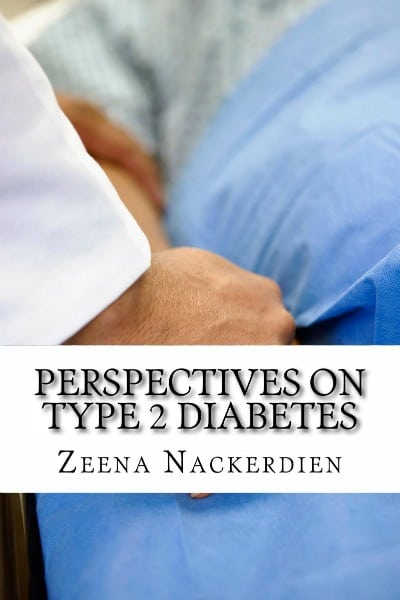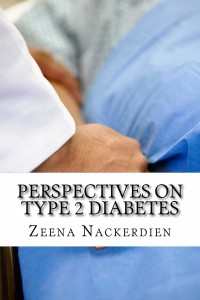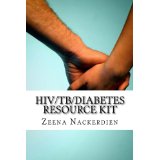Perspectives on Type 2 Diabetes’ Excerpt

I was raised in a loving family in a small town, Paarl, located in the Western Cape Province in South Africa. This story is boringly similar to many others reenacted around the globe. Growing up, love, laughter, and lots of good food washed down by sugary beverages were the order of the day. Today, as a middle-aged scientist, I realize that there may be a genetic component combined with lifestyle factors that make my branch of the family prone to Type 2 diabetes. During the intervening years I have eaten my way across the globe, watching my waistline shrink and expand, and met many interesting people whose diets and personalities varied, but who shared my passion for connections fostered over a good meal. Over time, routine annual physicals revealed that a sedentary and caloric-laden lifestyle were contributing to abnormal blood work and my primary care physician solicitously advised taking steps towards a healthier lifestyle, lest I fall victim to a disease known to occur in my family i.e., Type 2 diabetes. It was time for my inner nerd to take over and to study the condition. Hence, a new patient-friendly resource guide pooling pertinent information from My first stop was checking out resources from a country that counts the late-Dr. Frederick Banting, co-discoverer of insulin, among its iconic citizens. What did the Canadians have to say about risk factors for diabetes?
Interested readers are referred to the 2013 Canadian Clinical Practice Guidelines pertaining to Diabetes5 for the complete list e.g., “age ?40 years, first-degree relative with Type 2 diabetes; member of high-risk population (e.g. people of Aboriginal, African, Asian Hispanic, or South Asian descent); history of pre-diabetes ([impaired glucose tolerance test] IGT or [impaired fasting glucose] IFG or [glycated hemoglobin] A1c 6.0 to 6.4%); history of gestational diabetes mellitus; history of delivery of a macrosomic infant; presence of end organ damage associated with diabetes, microvascular (retinopathy, neuropathy, nephropathy); macrovascular (coronary, cerebrovascular, peripheral); presence of vascular risk factors ([high-density lipoprotein] HDL cholesterol level <1.0 mmol/L in males, <1.3 mmol/L in females triglycerides ?1.7 mmol/L, hypertension, overweight, abdominal obesity); presence of associated diseases (polycystic ovary syndrome, acanthosis nigricans; psychiatric disorders [bipolar disorder, depression, schizophrenia]; human immunodeficiency virus (HIV) infection; obstructive sleep apnea [OSA]); use of drugs associated with diabetes (glucocorticoids, atypical antipsychotics; Highly Active Antiretroviral Therapy [HAART ])5 I am writing based on anecdotal experience, heavily influenced by the deaths of relatives and celebrities I admired due to complications associated with a treatable condition e.g., the singer, Luther Vandross.
Much of the risk factors and clinical symptoms suggestive of diabetes mentioned in the ensuing chapters are simply checklists readily available from a local physician or a patient’s independent research. However, by infusing the facts with stories demonstrating ongoing struggles to integrate different streams of information and live up to evolving expectations, I hope to contribute to a dialogue aimed at encouragement instead of shame The second half of the book is for a general audience, in that it deals with a rejuvenated pipeline of antidiabetic therapies that may aid the management of diabetes and related complications (Chapter 5). These complications include cardiovascular conditions; kidney, nerve or eye diseases (diabetic nephropathy, neuropathy or retinopathy); increased risk of non-traumatic lower limp amputation; potential cognitive decline. If anyone has ever personally experienced any of these complications or cared for a loved one coping with diabetes, these chapters will resonate with them. I have provided a brief overview of key diabetic therapies, with the proviso that the information is not prescriptive and should always be evaluated with a qualified healthcare professional.
In addition, Chapter 6 focuses on the reality that most patients arrive at their doctors’ offices with diabetes and other comorbidities. Infections, whether due to an aberrant microbiome or the presence of known pathogens, such as HIV, tuberculosis (TB), or the hepatitis C virus (HCV), can confound even the most carefully-crafted treatment plan. I have included a section on the microbiome and diabetes in Chapter 6. Should any of these tantalizing associations hold up under rigorous clinical scrutiny, future treatment developments may include excluding or “overwhelming” pathogens by repopulating the gut with bacteria from a healthy individual, such as has been done in the case of managing Clostridium difficile infections. Finally I have prefaced the last chapter (Chapter 7) on patient education with a story illustrating how we all tend to fall off the dietary wagon over the holidays, before discussing some key approaches in the public and private sector to facilitate patient education.
Perspectives on Type 2 Diabetes by Zeena Nackerdien:
Publisher: Create Space (April 20, 2015)
CategoryNon-Fiction, Health, Type 2 Diabetes, HIV, TB, Patient Empowerment
Tour Dates: October/November, 2015
ISBN: 978-1511734837
ASIN: B00WGR90VK
Available in: Print & ebook, 41 Pages
The rising socioeconomic toll of diabetes, in particular, the Type 2 form of the disease, is reverberating around the world. A disease that has sporadically plagued mankind for centuries seems to have increased in prevalence in tandem with rapid economic transitions, notably in countries with the highest number of diabetics such as China and the USA.
This resource guide is comprised of information about diabetes in those countries as well as in the Middle East, North Africa, and South Africa. In addition, the latest antidiabetic therapies and infectious comorbidities associated with the disease are discussed in separate chapters. Scattered throughout the guide are fictional scenarios about challenges diabetics and their doctors might face in individualizing recommended management algorithms.
Praise for Perspectives on Type 2 Diabetes by Zeena Nackerdien:
Type 2 diabetes, characterized by the body’s progressive inability to utilize insulin, is rapidly approaching a prevalence of one in ten (9.3% in 2014) in both the U.S. and China. This silent epidemic manifests itself initally as a rise in blood sugar.
Dr. Nackerdien found herself challenged by signs of the early stages of this condition and has produced an excellent summary of early intervention goals and guidelines. This “translation” of technical information to an understandable guideline format is a must-have for real people who find themselves on the cusp of this debilitating condition.”- Curt, Amazon Reviewer
 HIV/TB/Diabetes Resource Kit by Zeena Nackerdien:
HIV/TB/Diabetes Resource Kit by Zeena Nackerdien:
Publisher: Create Space (April 23, 2015)
CategoryNon-Fiction, Health, Type 2 Diabetes, HIV, TB, Patient Empowerment
Tour Dates: October/November, 2015
ISBN: 978-1511864060
ASIN: B00WMNRDWG
Available in: ebook, 35 Pages
Who are the groups likely to be in the frontlines of either administering or receiving anti-HIV/AIDS-containing treatments for this disease and any associated comorbidities? The answer is frontline healthcare professionals, lay educators, and patients, especially in high-disease burden countries such as South Africa. While the reinvigorated national response to HIV/AIDS underscores the country’s commitment to the health crisis, the socioeconomic costs are likely to have a lasting impact on its citizens.
I have compiled a resource kit outlining some of the challenges faced in the treatment of patients with HIV, TB, and diabetes. In addition, the kit contains disease management and prevention tips suited for discussions with healthcare professionals, particularly in resource-poor settings.
About Zeena Nackerdien:
Zeena Nackerdien is a dual US and South African citizen. She obtained a PhD degree in Biochemistry from the University of Stellenbosch in South Africa. Zeena has been a research chemist at the National Institute of Standards and Technology in Maryland and a senior research associate at The Rockefeller University in New York.
She is the author of several publications in scientific journals and two poetry collections, “Mist Over Peace” and “Scatterlings.” As a scientist turned patient advocate and writer, she is intensely interested in building relationships with people from different cultures through story-telling and education. Zeena currently lives in Brooklyn, New York.
Website: http://www.heroinenextdoor.com/
Facebook: https://www.facebook.com/zeenasbooks
Google+: https://plus.google.com/105525451604342478576/posts
LinkedIn: https://www.linkedin.com/pub/zeena-nackerdien/9/175/b6a
Pinterest: https://www.pinterest.com/zulu2/zeena-nackerdien/
Buy Perspectives on Type 2 Diabetes by Zeena Nackerdien:
Amazon
Barnes & Noble
Book Depository
Buy HIV/TB/Diabetes Resource Kit by Zeena Nackerdien:
What's Your Reaction?
Newly middle-aged wife of 1, Mom of 3, Grandma of 2. A professional blogger who has lived in 3 places since losing her home to a house fire in October 2018 with her husband. Becky appreciates being self-employed which has allowed her to work from 'anywhere'. Life is better when you can laugh. As you can tell by her Facebook page where she keeps the humor memes going daily. Becky looks forward to the upcoming new year. It will be fun to see what 2020 holds.






